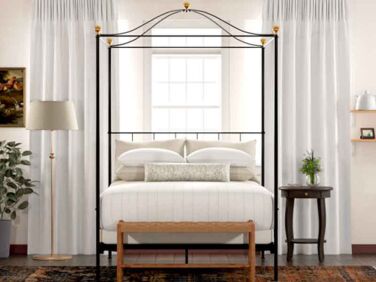Given that we spend about a third of our lives in bed, it’s crucial to invest in a high-quality mattress and frame to support it. But how to find a setup that will last? We chatted with the experts at Charles P. Rogers, the original American bed maker, to find out.
Established in 1855, Charles P. Rogers has served generations of satisfied customers who flock to the company for its heirloom-quality beds (including canopy beds) and mattresses. “You want to look for a bed that will last in both quality and style,” the company tells us. “As we get more and more focused on sustainability, you don’t want something that is just going to end up in a landfill or something that you’ll get tired of easily and want to replace.”
Here are the four things to look for when you’re in the market for a bed.
(N.B.: Use code SPRING23 for an additional $100 off.)

1. Look for time-tested materials.
Furniture waste is a big problem, with more than 9.6 million tons of it ending up in landfills in 2019. For the bed—and every piece in your home—it’s important to find furniture that’s designed to last, not be disposable.
For a bed frame, look for solid, not composite, materials like solid hardwood and metal. “Rogers beds are made with solid iron, brass, and mahogany with detailed finishes, and they’re built to hold today’s heavy mattresses,” Charles P. Rogers reports. The metal beds feature metal-to-metal connections that create a rigid (and therefore durable) frame; its wood beds are kiln-dried, finished by master craftsmen and hand tools, and use traditional joinery that can expand and contract with changing temperature and humidity.

2. Go for timeless, not trendy.
One factor in the longevity of a bed is style. If you choose something trendy and of the moment, you’ll likely want something new in a few years—not a sustainable or budget-friendly situation. Instead, opt for a timeless look that will fit seamlessly no matter where you move or how your style might evolve. Rogers beds, for example, “harken back to a different age and are inspired by our history, but they are proportioned for today’s rooms,” according to the company.

3. Prioritize sustainability.
It’s important to look at the individual components of a bed and research their origins, keeping an eye out for sustainable practices. In the case of Rogers beds, most of the steel and brass (and mattress springs, too) is post-industrial recycled material—and it’s 100 percent recyclable in the event your bed reaches the end of its lifespan. The hardwood is responsibly harvested from plantations rather than natural forests. And look at the smallest details, too: The adhesives and finishes in a Rogers mattress are natural or are water based and non-toxic, without solvents. Lastly, finishes are designed to be fully repairable—no need to toss a bed if it gets worn or nicked.

4. Don’t skimp on comfort.
A mattress is a long-term (and oft-used) purchase—and it’s important to find one that’s nontoxic, comfortable, and made to last. While everyone has different sleep preferences, Rogers prioritizes comfort and support as a baseline across all its mattresses while offering different levels of firmness. The company favors traditional springs (over foam) as a foundation, and its Powercore Mattress Unit uses specialized springs designed in house, which supports all shapes and sizes and adapts to each individual sleeper. Mattresses can be topped with different padding and fabric—including latex, memory foam, Dupont Sorona (a natural fiber-based padding), and nano springs—and each mattress comes with a lifetime warranty.
Whatever your preferences, be sure to avoid urethane foam, chemical treatments, PBDE, CFCs, mercury, lead—as Rogers mattresses do—and look instead for responsibly sourced and non-toxic materials.
For more, head to Charles P. Rogers (and see how their beds are made here).
N.B. Shown in the featured image: the Cairo Canopy Bed, made from hand-forged wrought iron, “perfect for draping or leaving open and fresh.”










Have a Question or Comment About This Post?
Join the conversation (0)